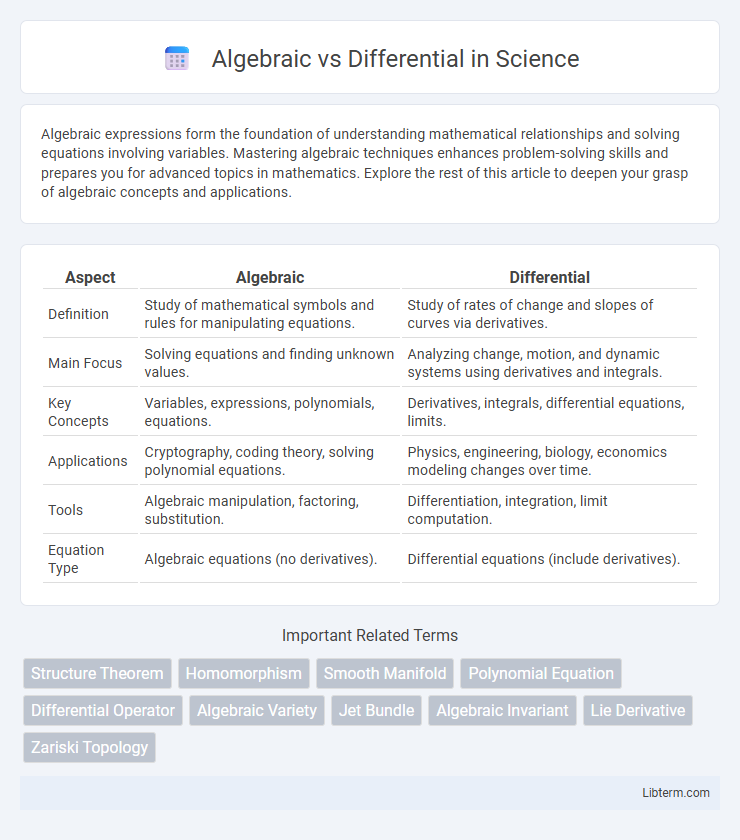Algebraic expressions form the foundation of understanding mathematical relationships and solving equations involving variables. Mastering algebraic techniques enhances problem-solving skills and prepares you for advanced topics in mathematics. Explore the rest of this article to deepen your grasp of algebraic concepts and applications.
Table of Comparison
| Aspect | Algebraic | Differential |
|---|---|---|
| Definition | Study of mathematical symbols and rules for manipulating equations. | Study of rates of change and slopes of curves via derivatives. |
| Main Focus | Solving equations and finding unknown values. | Analyzing change, motion, and dynamic systems using derivatives and integrals. |
| Key Concepts | Variables, expressions, polynomials, equations. | Derivatives, integrals, differential equations, limits. |
| Applications | Cryptography, coding theory, solving polynomial equations. | Physics, engineering, biology, economics modeling changes over time. |
| Tools | Algebraic manipulation, factoring, substitution. | Differentiation, integration, limit computation. |
| Equation Type | Algebraic equations (no derivatives). | Differential equations (include derivatives). |
Introduction to Algebraic and Differential Methods
Algebraic methods involve solving equations by manipulating algebraic expressions using operations such as addition, subtraction, multiplication, and division, which is essential for finding exact solutions to polynomial and linear equations. Differential methods focus on analyzing functions' rates of change and slopes through derivatives and differential equations, playing a crucial role in modeling dynamic systems and continuous phenomena. Understanding both algebraic and differential techniques expands problem-solving capabilities across mathematics, physics, and engineering disciplines.
Defining Algebraic Equations
Algebraic equations are mathematical statements using operations such as addition, subtraction, multiplication, and division on variables raised to whole number powers, expressing relationships without involving derivatives. These equations define polynomial, rational, and radical expressions where the unknown variables are solved based on constants and coefficients. Unlike differential equations, algebraic equations do not incorporate rates of change or functions' derivatives within their structure.
Understanding Differential Equations
Differential equations describe relationships involving rates of change and are essential for modeling dynamic systems in physics, engineering, and biology. Unlike algebraic equations, which solve for variables without involving derivatives, differential equations require techniques such as separation of variables, integrating factors, or numerical methods for solutions. Mastering differential equations enhances the ability to predict system behavior over time, making them critical in fields like fluid dynamics, population modeling, and control theory.
Key Differences Between Algebraic and Differential Approaches
Algebraic approaches solve equations using finite operations such as addition, multiplication, and root extraction to find explicit expressions for unknowns. Differential approaches involve equations containing derivatives that describe rates of change and dynamic behavior over continuous variables. Key differences include algebraic methods focusing on static relationships and exact solutions, while differential methods emphasize modeling dynamic systems and analyzing continuous transformations.
Common Applications of Algebraic Methods
Algebraic methods are commonly applied in solving polynomial equations, analyzing algebraic structures such as groups and rings, and optimizing linear systems within engineering and computer science. These techniques are fundamental in cryptography, error-correcting codes, and computational geometry, enabling efficient algorithm development. Unlike differential methods, algebraic approaches excel in discrete problem-solving and symbolic computation, facilitating exact solutions in mathematics and theoretical physics.
Real-World Uses of Differential Techniques
Differential techniques play a crucial role in real-world applications such as engineering, physics, and economics by enabling precise modeling of dynamic systems and continuous change. Unlike algebraic methods that solve static equations, differential calculus helps analyze rates of change, optimize functions, and predict future behavior in complex systems like fluid dynamics, population growth, and financial markets. These methods form the mathematical foundation for innovations in technology, control theory, and data analysis, driving advancements across numerous scientific and industrial fields.
Solution Strategies for Algebraic Equations
Solution strategies for algebraic equations primarily involve isolating variables through operations like addition, subtraction, multiplication, division, and factoring. Techniques such as substitution, elimination, and using the quadratic formula effectively address linear and polynomial equations. Understanding the role of coefficients and constants enables precise manipulation to find exact roots or values satisfying the equation.
Techniques for Solving Differential Equations
Techniques for solving differential equations include separation of variables, integrating factors, and characteristic equations, which transform complex problems into manageable algebraic forms. Exact equations and Laplace transforms provide systematic approaches for linear and non-linear cases, enhancing solution accuracy. Numerical methods like Euler's and Runge-Kutta algorithms offer practical tools for approximating solutions when analytical methods fail.
Choosing Between Algebraic and Differential Methods
Choosing between algebraic and differential methods depends on the problem's nature and goals, where algebraic techniques excel in solving equations with a finite number of variables and explicit relationships, while differential methods are preferred for modeling dynamic systems involving rates of change and continuous variables. Algebraic approaches often provide exact solutions through manipulation of variables and constants, ideal for static system analysis. Differential methods, including differential equations, capture real-world phenomena like growth, decay, and motion, offering insights into system behavior over time.
Future Trends in Algebraic and Differential Analysis
Future trends in algebraic and differential analysis emphasize the integration of machine learning techniques to enhance predictive modeling and problem-solving accuracy. Advances in computational power enable more complex algebraic structures and differential equations to be analyzed in real-time, expanding applications in quantum computing and dynamic systems modeling. Research in hybrid methods combining symbolic algebra and numerical differential approaches is driving breakthroughs in automation, optimization, and data-driven science.
Algebraic Infographic

 libterm.com
libterm.com